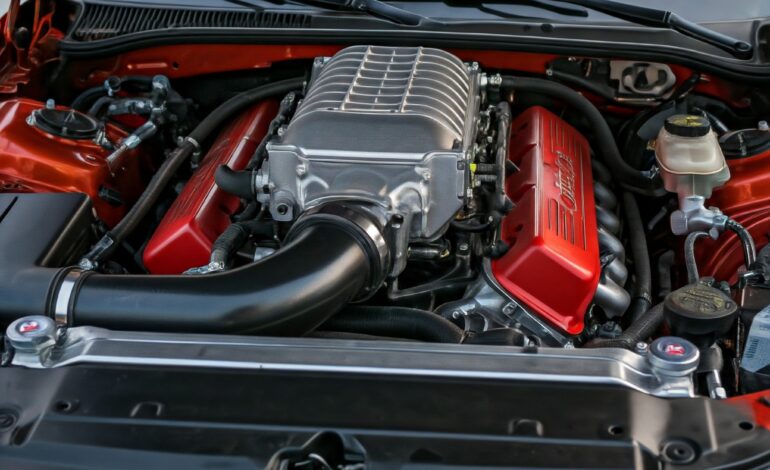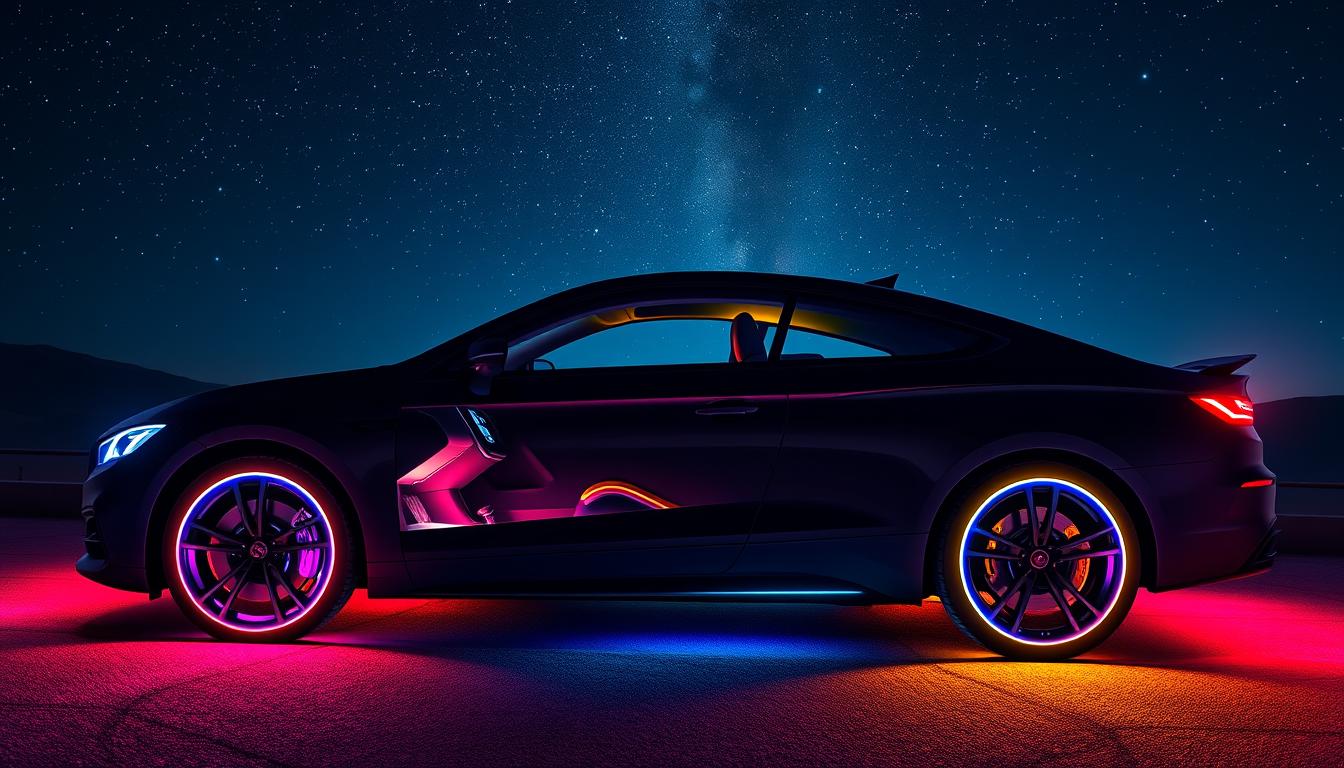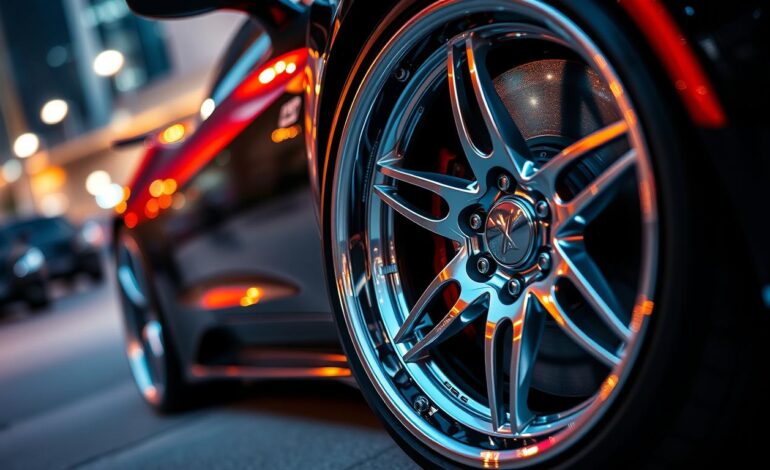
Upgrading Your Rims: Choosing the Right Size and Style
Upgrading your vehicle’s rims can make it look and perform better. There are many choices, from custom rims to different sizes. Custom rims are a favorite among car lovers because they let you make your vehicle truly yours.
This guide will help you pick the best custom rims for your car. Whether you want better performance or a new look, we’ve got you covered. With so many options, it’s easy to get lost. But with the right info, you can choose the perfect custom rims for your needs.
Key Takeaways
- Custom rims can enhance your vehicle’s appearance and performance
- Choosing the right rim size and style is key for a great upgrade
- Custom rims offer a unique way to personalize your vehicle
- There are many options available, from different materials to various rim sizes
- Research and planning are key to finding the perfect custom rims for your vehicle
- Upgrading your rims can be a cost-effective way to improve your vehicle’s overall look and performance
Understanding the Basics of Rim Upgrades
Upgrading your vehicle’s rims is a big step. It’s important to know what aftermarket rims are and their benefits. You should also be familiar with common terms. Aftermarket rims come in different rim sizes. Knowing these sizes is key to finding the right fit for your vehicle.
Upgrading your rims can make your vehicle look better and possibly perform better. It also lets you personalize your vehicle to your liking. When upgrading, consider a few things:
- Load rating requirements
- Offset and backspacing considerations
- Diameter and width specifications
Understanding these factors helps you choose the right rims. It’s also important to think about how the rim sizes will affect your vehicle’s look and performance.
When choosing new rims, think about how they’ll look too. There are many styles and materials to pick from. You can make your vehicle truly unique.
What Are Aftermarket Rims?
Aftermarket rims are designed to improve your vehicle’s performance and look. They’re made from quality materials and are built to last.
Benefits of Upgrading Your Rims
Upgrading your rims can offer many benefits. You might see better handling, more fuel efficiency, and a cooler look.
Common Terminology You Should Know
When upgrading your rims, it’s key to understand terms like rim sizes, load rating, and offset. Knowing these will help you make a smart choice and find the perfect rims for your vehicle.
Measuring Your Current Wheels for the Perfect Fit
Measuring your current wheels is key for a smooth drive. You need to know the diameter, width, and offset. This info helps pick the right rims for your car.
Choosing the right car wheels matters. They impact how your car looks and performs. For example, alloy wheels are durable and stylish. Steel wheels are strong and affordable.
Here’s what to measure:
- Diameter: The distance from one wheel edge to the other.
- Width: The distance from the inner to the outer edge.
- Offset: The distance from the wheel’s center to its edge.
Measuring and choosing wisely will get you the perfect wheels. Whether you want style or better performance, the right wheels make a big difference.
Essential Factors That Affect Rim Selection
Choosing the right custom rims for your vehicle involves several key factors. It can seem overwhelming, but knowing what to look for helps. This knowledge ensures your car wheels perform well and look great.
First, consider if the rims fit your vehicle. Load ratings are also important, if you carry heavy loads. Offset and backspacing considerations are key for a good fit and to avoid clearance problems.
Vehicle Make and Model Compatibility
It’s vital to pick rims that match your car’s make and model. This ensures a perfect fit and the best performance.
Load Rating Requirements
Think about the load rating if you often carry heavy loads. Choose rims with the right load rating to handle the weight safely.
Offset and Backspacing Considerations
Offset and backspacing are important for a proper fit. They help avoid rubbing against other parts of your car.
By considering these factors, you can find the perfect custom rims for your vehicle. Remember to focus on compatibility, load rating, and offset and backspacing. This ensures your rims fit well and perform at their best.
| Factor | Consideration |
|---|---|
| Vehicle Make and Model | Compatibility with car wheels |
| Load Rating | Weight and stress of heavy loads |
| Offset and Backspacing | Proper fit and clearance issues |
Popular Rim Styles and Materials
Choosing the right rim sizes for your vehicle is important. The market has many rim styles and materials. Alloy rims are light and don’t rust, making them a favorite among car lovers.
Steel rims, on the other hand, are strong and last long but are heavier. The right rim material depends on your car, how you drive, and what you like. Car wheels with big rim sizes look great but might change how your car handles and uses fuel.
Some popular rim styles include:
- Alloy rims with a polished or chrome finish
- Steel rims with a matte or powder-coated finish
- Forged rims for high-performance vehicles
Make sure your chosen rim style fits your car’s make and model. Talking to a pro or checking your car’s manual is a good idea. The right rim sizes and materials can make your car wheels look and perform better.
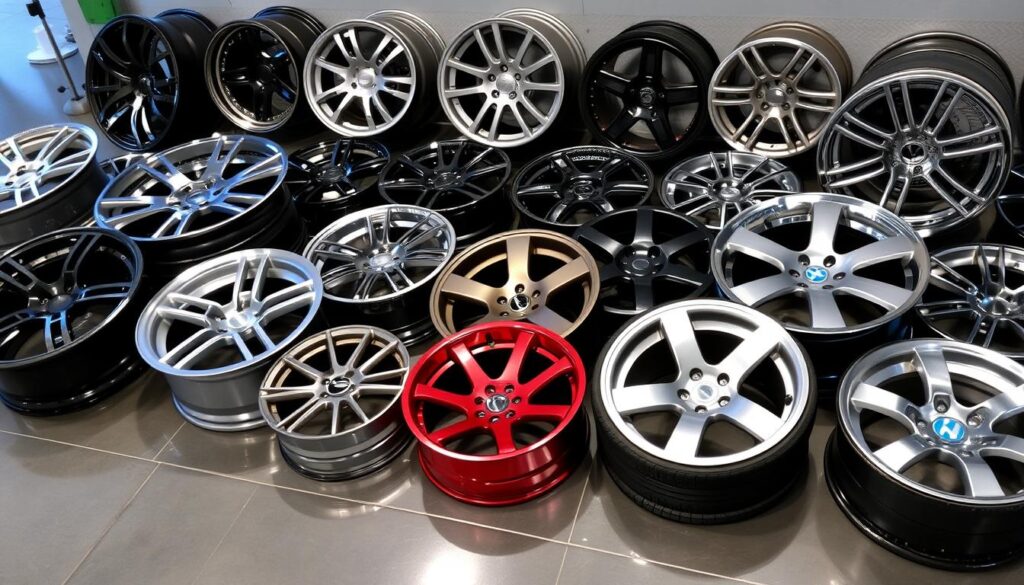
Understanding Rim Sizes and Fitment
When you’re looking at custom rims, knowing about rim sizes and fitment is key. Rim sizes are about the diameter and width of the rim. They need to match your vehicle’s make and model for a good fit. The right sizes mean a smoother ride, better handling, and more safety.
Choosing the right custom rims involves looking at a few things. You need to think about the bolt pattern and whether to go with hub-centric or lug-centric mounting. Hub-centric mounting gives a more stable fit. Lug-centric mounting lets you pick from more rim sizes and styles.
Here are some important things to think about when picking custom rims:
- Rim diameter and width specifications
- Bolt pattern measurements
- Hub-centric vs. lug-centric mounting
- Load rating requirements
- Offset and backspacing considerations
Understanding rim sizes and fitment helps make sure your custom rims fit right. This boosts your vehicle’s look and performance. Whether you want something sleek or something tough, there’s a rim out there for you.
| Rim Size | Bolt Pattern | Mounting Type |
|---|---|---|
| 17×8 | 5×114.3 | Hub-Centric |
| 18×9 | 6×139.7 | Lug-Centric |
How Rim Upgrades Impact Vehicle Performance
Changing your car wheels can really change how your vehicle performs. The size and style of your rims can change your car’s weight and how it moves through the air. This can affect how well your car handles and stays steady.
For example, bigger rims can make your car handle better by giving it a wider tire. But, they can also make your car heavier, which might use more fuel.
When you think about changing your rims, remember how they’ll change your car’s performance. Here are some important things to think about:
- Handling and stability: Bigger rims can make your car handle better, but they might make it less stable if you drive fast.
- Fuel efficiency: The weight and design of your rims can also affect how much fuel your car uses. Lighter rims usually mean better gas mileage.
It’s key to understand how new rims will change your car’s performance. By thinking about handling, stability, and fuel use, you can pick the best rims for your car. This will help your car perform better and keep you safe on the road.
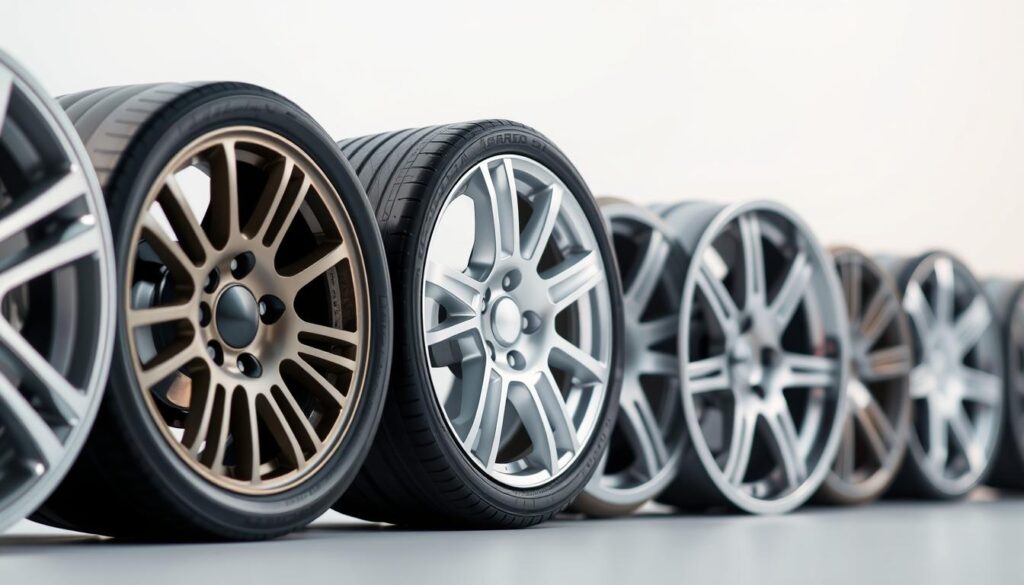
In short, changing your rims can really change your car’s performance. It’s important to think about how it will affect handling, stability, and fuel use. By picking the right rims, you can make your car better to drive and safer to be in.
Budget Considerations and Price Ranges
Upgrading your vehicle with custom rims can be pricey. The cost depends on the material, size, and brand. Setting a budget is key to finding the right rims without overspending.
Here are some factors to consider when setting your budget for custom rims:
- Material: Different materials, such as aluminum or steel, can affect the price of the rims.
- Size: Larger rims can be more expensive than smaller ones.
- Brand: Certain brands may be more expensive than others due to their reputation, quality, or design.
Think about the long-term value and durability of the custom rims, plus any installation costs. By researching and comparing prices, you can find the perfect custom rims for your vehicle that fit your budget.
Investing in high-quality custom rims can improve your vehicle’s look and performance. It’s a good choice for many car lovers.
Professional Installation vs. DIY
Choosing between professional installation and DIY for new car wheels is a big decision. The right fit and secure rims are key for safe driving. Wrong installation can cause uneven tire wear and affect handling.
If you’re doing it yourself, make sure you have the right tools. You’ll need a lug wrench, tire pressure gauge, and wheel chocks. Incorrect torque specifications and improper balancing of the rims are common errors. They can cause uneven wear and even wheel failure.
Tools Required for Installation
- Lug wrench
- Tire pressure gauge
- Wheel chocks
- Hub-centric rings (if necessary)
Professional installation ensures your rims fit right and are secure. It uses the correct rim sizes for your car. This gives you peace of mind and prevents future problems. Whether you do it yourself or get a pro, safety and integrity of your car’s wheels are key.
Common Installation Mistakes to Avoid
Some common mistakes include wrong torque, bad rim balancing, and not tightening lug nuts right. Knowing these mistakes and taking steps to avoid them can lead to a safe and successful installation. This is true whether you’re doing it yourself or getting a professional to do it for you.
| Mistake | Consequence |
|---|---|
| Incorrect torque specifications | Uneven wear, wheel failure |
| Improper balancing of the rims | Vibration, uneven wear |
| Failing to tighten lug nuts in a star pattern | Wheel damage, brake problems |
Maintaining Your New Rims
To keep your custom rims in top shape, regular care is key. This means cleaning and looking after them, plus doing seasonal checks to guard against the weather. Knowing how to care for your rims, based on their material and finish, will make them last longer.
If your rims are aluminum, steer clear of harsh cleaners or rough scrubbers. Use gentle soap and water to clean them, and make sure to dry them well to avoid water spots.
Cleaning and Care Tips
- Use a soft-bristled brush to remove dirt and debris from the rim’s surface
- Avoid using high-pressure washes or harsh chemicals that can damage the finish
- Dry your custom rims thoroughly after cleaning to prevent spotting
Seasonal upkeep is also vital for your rims. For instance, in winter, applying a protective layer can shield them from salt and ice melters.
Seasonal Maintenance Requirements
By following these tips and taking the time to properly maintain your custom rims, you can help extend their lifespan and keep them looking their best. Always check your manufacturer’s guidelines for specific care advice for your custom rims.
Legal Considerations and Regulations
Upgrading your car wheels and rim sizes comes with legal rules to follow. You must meet local and national safety and emissions standards to avoid fines. In the United States, the Department of Transportation (DOT) and the National Highway Traffic Safety Administration (NHTSA) set these rules.
Important things to think about include load rating requirements and offset and backspacing considerations. Make sure your new rims fit your car’s make and model. Not following these rules can lead to fines, vehicle registration suspension, and higher insurance costs.
- Fines and penalties
- Vehicle registration suspension
- Increased insurance rates
To avoid these problems, research the legal needs in your area before changing your car’s wheels and rims. You can learn more on the DOT and NHTSA websites or talk to a mechanic or auto parts expert. By following the rules, you can enjoy your new rims safely and legally.
Changing your car’s wheels and rims can make it look and perform better. But, safety and following the law are key. By focusing on these, you can enjoy your new rims without worrying about legal trouble.
| Regulation | Description |
|---|---|
| DOT Regulations | Ensure compliance with safety standards for car wheels and rim sizes |
| NHTSA Guidelines | Provide guidance on load rating requirements and offset and backspacing considerations |
Conclusion: Making Your Final Rim Selection
Choosing the right rims can change how your car looks and performs. Custom rims and the right rim sizes can make your car stand out. Premium car wheels can also improve how your car handles and uses fuel.
Think about what you want your car to look like. Do you want bold rims or something more simple? The most important thing is to pick rims that fit your car and your style. If you’re not sure, getting advice from a pro can help a lot.
Once you’ve got your rims, take care of them. This will keep them looking great for a long time. With the right care, your new rims will make your car look amazing and drive even better.

